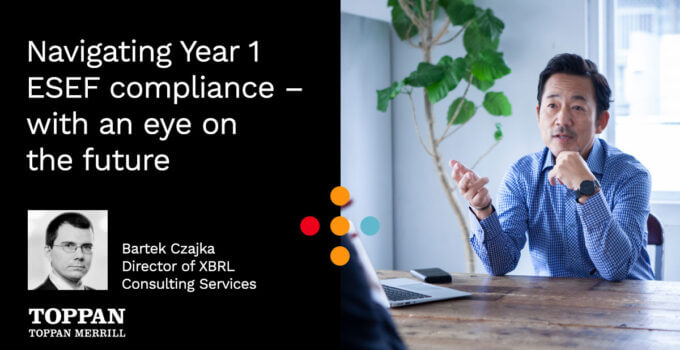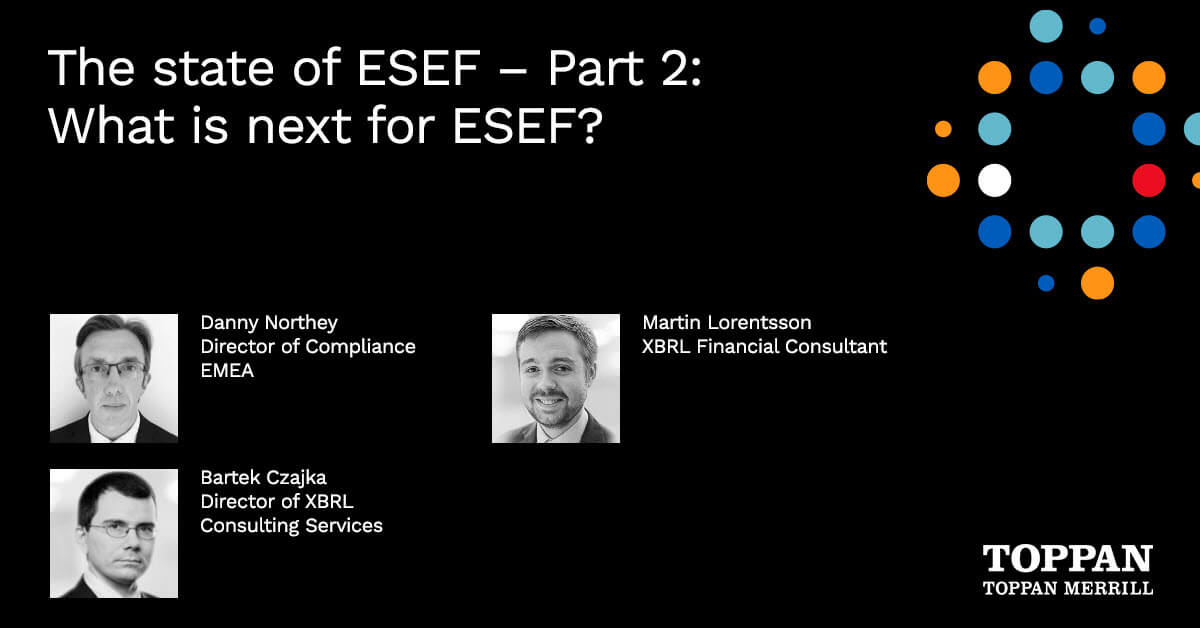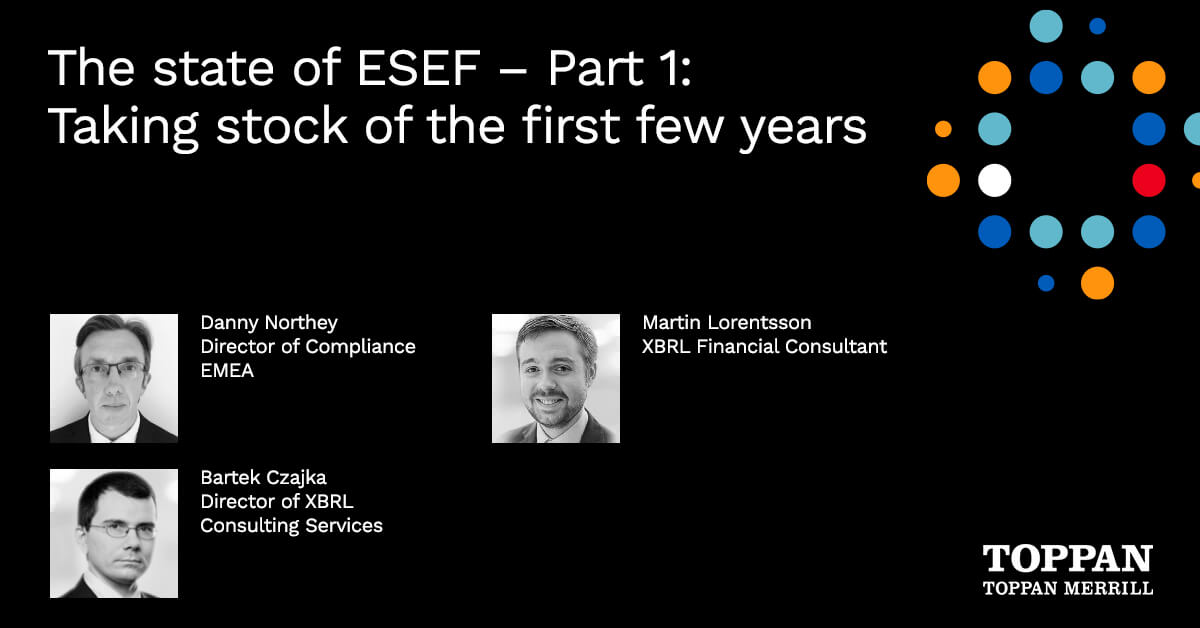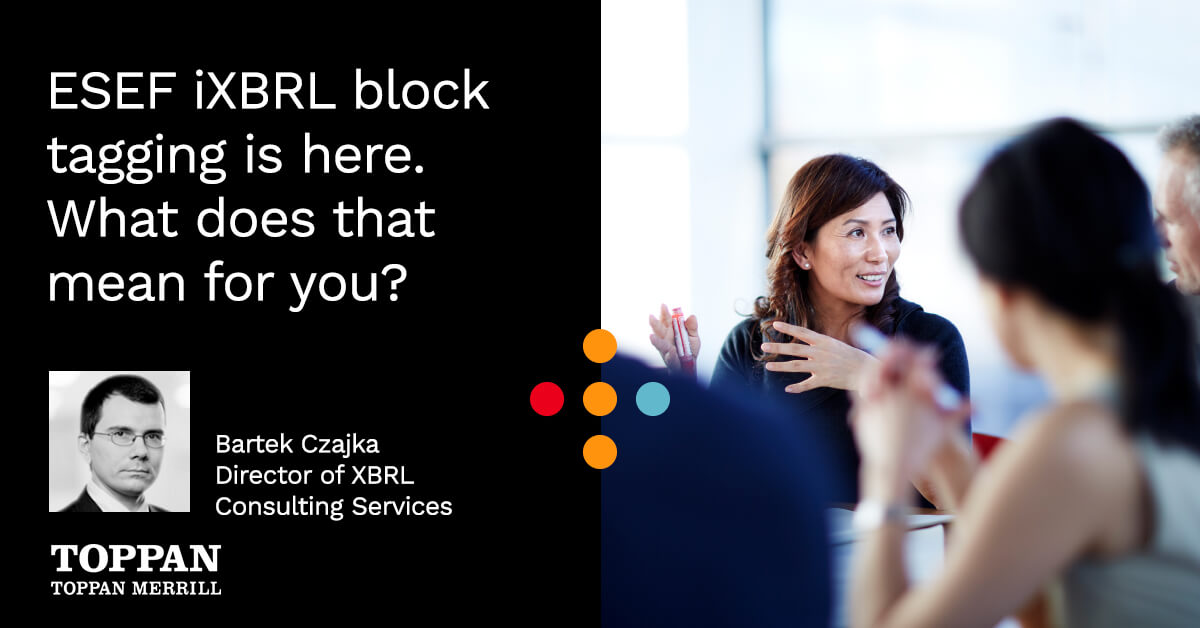With any big change, it is easy to fall into one of two traps. The first is tunnel vision: Focusing too narrowly on what is immediately in front of you with Year 1 requirements and challenges, and “not seeing the forest for the trees.” The second is getting ahead of yourself: Focusing too much on trying to prepare for the future – and overcomplicating things right now. Both of these traps are really just parts of human nature. So, to help companies find a path to ESEF iXBRL compliance that addresses both the here-and-now and the future, here is a year-by-year set of tips and areas to focus on:
Year 1: Getting familiarized with the requirements
ESMA’s Year 1 requirements for ESEF include major changes, for sure. But most companies do not actually have to change that much about their internal workflows in order to meet Year 1 requirements. Here are a couple things to keep in mind:
- Software is not necessary – you can let a vendor partner handle tagging
There are a lot of loud voices saying that companies need to select a software product to handle XBRL tagging for Year 1. Companies are understandably hesitant – how do you make an informed choice when this is your first time with XBRL tagging? The truth is that a software subscription is not necessary and might not be the best option for many companies in Year 1. For the first year, most companies can take the “easy path”: keeping their internal workflows for preparing financials exactly as they are, and just handing the draft PDF off to a trusted vendor partner to do the XBRL tagging. And if you do buy software, you still do not have to do XBRL tagging alone – you can engage the expertise of a vendor partner to help you with tagging and review.
- Software alone can’t deliver 100% XBRL accuracy
Some AI-powered software products for XBRL tagging do a decent job, but are likely to only get you to about 80% accuracy. You still need human expertise to handle the complexities of your financials. For example, anchoring is an important part of the ESEF iXBRL Year 1 requirement, and no software solutions currently are able to produce good quality automated anchoring. Anchoring – connecting a newly created element (something in your financials) with an existing IFRS taxonomy element (something outside your financials) – is new to everyone, including AI. How do you teach an AI system to do something no one has done before? You can’t. That’s why software alone can’t get you all the way to 100% tagging accuracy.
- Focus on the review:
Here is the advice I have given to most companies on Year 1: Find a vendor partner that you trust to get the tagging right; then focus your attention on the XBRL tagging review. There is not much time left to be figuring out how to do the actual tagging completely on your own. It is going to be much more efficient (and effective) to let an expert handle the tagging – and make sure you have time and resources allotted for detailed review. This is the best way to use your specific expertise (in-depth knowledge of your company’s financials) to support the accuracy of your XBRL tags. The review is also a great opportunity to get familiar with the XBRL tags that you will be using in the future, so you have a basic understanding of your tagging and helps you tell the right story about your company.
- Remember: Year 1 accuracy MATTERS
It is tempting to think of Year 1 as a trial-and-error year for XBRL. But while the requirements might not appear complicated – and your internal process less impacted – XBRL accuracy remains imperative from the start. What you produce in Year 1 will exist in the public domain forever – and any errors in that data will persist, as well. That Year 1 data will only be used more and more frequently in future years, as the general XBRL dataset reaches a critical mass for meaningful, broad-scale analysis. That means that, while errors or inaccuracies in your XBRL might not be apparent immediately, they will likely come back to impact you in the future. Bottom line: Do not treat Year 1 as a “practice round” – get it 100% right from the onset.
Year 2: Adding value
By Year 2, you will have an enormous amount of knowledge and experience to leverage. Most companies won’t make significant workflow changes from Year 1 to Year 2, but you may begin exploring ways to add value, drive efficiency and support accuracy.
- Assess Year 1 — what worked, what didn’t?
One of the most important things is to do a thorough “post-mortem” on Year 1.
- What were the biggest challenges or pain points in the process of preparing your financials, adding XBRL tags, and reviewing and submitting?
- Did you experience bottlenecks due to a lack of internal resources, expertise or technological capability?
- How can you turn these negative experiences into opportunities to add value to the process in Year 2
On the flip side, what aspects of the process went particularly smoothly and worked well with your existing internal workflows? Focus on protecting these positives as you amend your processes, technologies and strategies going forward.
- Look for software that lets you prepare and tag your financials
I mentioned bolt-on software products that promise to deliver fully automated XBRL tagging. Beyond the accuracy limitations of these products, there is another shortcoming: they are one-trick ponies. Good software should let you do more than just tag your financials. There are software solutions out there now that allow you actually prepare your financials within the software solution – and also enable high-quality XBRL tagging and creation of an xHTML file.
- Software should let you work the way you want to work
If you are going to take advantage of a software solution that lets you prepare and tag your financials, it should not require you to completely change the way your team works and collaborates. They should allow you to integrate the tools your team is already using and continue working the way you want to work. For example, letting you integrate Excel® tables or Word documents seamlessly within the software platform. Best-in-class software takes that a step further, using cloud-driven platforms that let your team simultaneously work and iterate on the same document to accelerate your workflows and simplify collaboration.
Year 3+: Making Future-Proof Decisions
Looking toward Year 3 and future years, it is important to remember that ESEF iXBRL requirements are likely to become more complicated, with things such as detailed note tagging. As you consider how you will use software to enhance your preparation and tagging workflows, make sure you are taking the following into consideration:
- Software still may not be the best option
As your familiarity with XBRL increases, and as requirements potentially grow more complex, you should certainly consider how software can help. But you may still find that the best option for your company is to take a traditional approach – maintaining your current internal workflows and leaving the XBRL tagging (including detailed note tagging) to a trusted vendor partner. In fact, as the requirements get more complex, it might make sense to focus your attention and resources on preparing your financials, leave the tagging to the experts, and then focus on a detailed review.
- Evaluate software with a 5-year outlook
Just as many of the software products on the market today are designed to meet a bare-minimum standard for Year 1 requirements, be cautious in future years of software designed only to meet the current ESEF requirements. Accountants are well-versed in evaluating long-term value to ensure a protected investment for the company, and you should apply this same principle as you evaluate a software solution to help you with preparing and tagging your financials. In short, do not buy software to help you today; buy software that helps you achieve future success – addressing future challenges and helping you achieve future operational goals.
- Make sure software is tested to meet future requirements.
As an addendum to the point above, do not take a software vendor’s word for it. The agile nature of software platforms makes it easy (and tempting) for a software vendor to assure you that their solution will be able to meet potential future requirements. These promises are not necessarily disingenuous – they plan to, and believe in their ability to, evolve their software as requirements change. But if you are aiming to make a truly protected investment in a future-proof software solution, the vendor should be able to show you the testing to prove they can support future requirements. Ask to see the proof.
Three years is a long time – and also a very near future. It is tough to balance these two truths, without overweighting one or the other. But if I can sum up all this advice into three sentences, I would say this:
- You do not need to overcomplicate Year 1. Find a simple solution that works for you and delivers 100% XBRL accuracy
- Remember: Your financial story depends on it
- Make sure any decision to add software truly adds value for your team
- And make sure you are making smart investments that are ready for future financial reporting requirements
Toppan Merrill is here to help.
Based across Europe, the dedicated XBRL trained and certified team at Toppan Merrill has worked with numerous companies throughout EMEA to confidently prepare and submit their annual reports. Visit our ESEF Reporting page to learn more – or connect with one of our experts at [email protected] or by calling +44 20.7422.6100.



